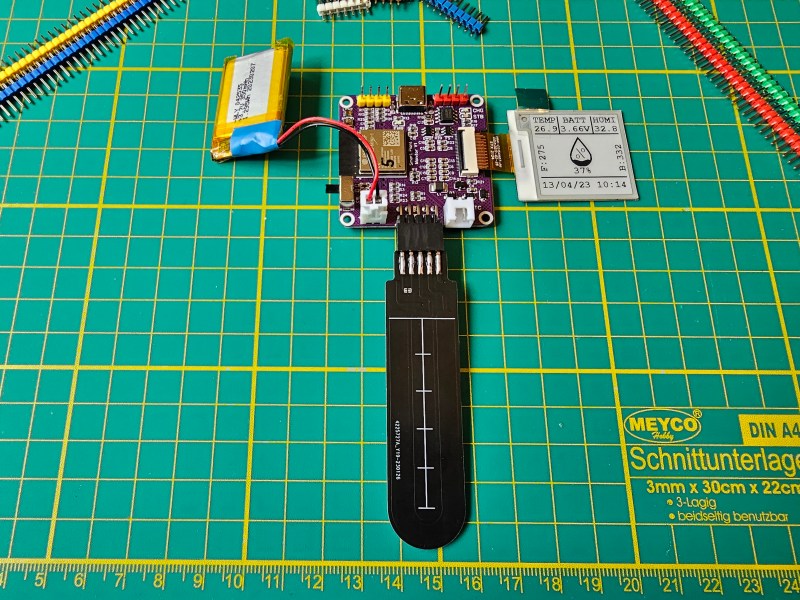[Ovidiu] cares for their house plants, trying to dial in the perfect soil humidity and light levels. However, many cheap monitors tend to rust after a few weeks of sitting in a damp, slightly acidic environment. By creating a custom plant monitor with a removable probe, not only can [Ovidiu] integrate better with their Home Assistant setup, but it will also be less wasteful.
The build starts with an ESP32-S3, a TP4056 charging circuit, a small e-ink display, and an AHT20 IC for air humidity and temperature. The ESP32 reads the probe using the capacitance measuring devices for touchpads built into the chip. Or course, a 450mAh battery provides a battery life of about 11 days. The probe is just a bare PCB with a connector at the top, making them cheap and easy to swap. They included pads on the probe for a thermistor for reading soil temperature, but this is optional. A handsome 3D-printed case wraps it all up nicely.
To further extend the battery, [Ovidiu] added a small solar panel via the header they left on the top of the project for expansion. All the code, schematics, and STL files are up on GitHub for your perusal. Of course, this isn’t the first project we’ve seen that uses swappable capacitive probes, but we love seeing people continue to iterate on good ideas.



















Speaking of plant sensors with removable capacitive soil probe, I have made a homeassistant compatible sensor just like this that runs one year on replaceable CR2032 batteries. You can check it out here if interested:
Tindie: https://www.tindie.com/products/29695/
Official page: https://sensus.klausen.tech
The sensor is really easy to setup, just power it up and it shows in Homeassistant. It also collects soil temperature, air temperature and humidity, as well as illuminance and also has a PC interface for data logging and firmware upgrade.
Sorry for the self-plug, I hope it’s not too intrusive, but I know someone who needs this kind of sensor might read the comments!
Had a look at it and I would get concerned with water ingress with the ribbon connector being right at the top where rain would hit the plant.
Solution would be to fill it up with sealant but then the probe (which will presumably corrode over time) can’t be replaced.
Yeah, that’s why the probe needs to be cheap and easily replaceable. I could also have the probe + cable as a single sealed unit but that’s not something I can or have the time to do at home in a reliable way.
Regular watering over the connector doesn’t seem to have affected any of my 3 test sensors for almost a year, so even if I would have to change the probe due to corrosion, I think 1 year is a pretty good lifetime for a 5$ probe 😃
Anyways, I’m not really marketing it as a outdoor plant sensor, it’s more suited for indoor plants and can be used outdoors while keeping in mind that the probe will need to be replaced more often.
All in all, in my biased opinion, water doesn’t do much to the probe over the course of 1 year and even if you have to replace the probe after a year, that’s no problem since the probes are cheap.
What do you say?
I was more concerned with water getting into the main unit not the probe. Indoor use its probably fine unless you miss with the watering can, but even on a balcony I would get a bit nervous with this thing (main body, not probe) surviving more than 3 months.
I get a lot of rain which is why I would be concerned with such a larger hole pointed directly upward, either it’s getting directly into the box or it’ll pool there and seep in.
On a slightly related note, is there a standard connection/spec for probes? I see a lot of them and they look quite similar so maybe having a standard electrical connection means that people can specialise in the probe and controller unit separately. I would love to see a high quality probe that multiple projects utilise that is produced in slightly larger quantities to get the cost down.
There’s also this utilitarian, great performing device:
https://www.tindie.com/products/miceuz/chirp-plant-watering-alarm/
The author created the sensor from scratch and it turned out it also detects light levels as a side-effect so the gadget uses a blinky light instead of sound to notify of time to water during night time :)
Rust is iron oxide. Not *any* metal oxide.